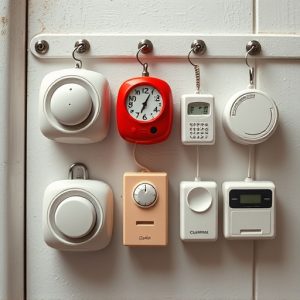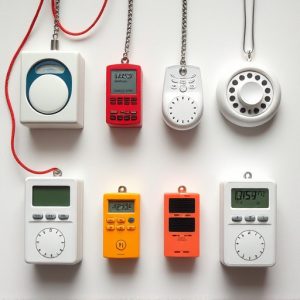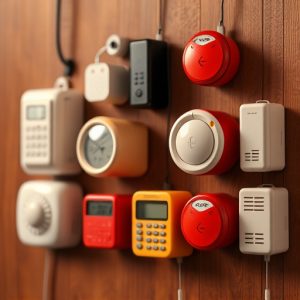Personal Alarms: Protecting Safety in Buildings and Beyond
Handheld personal protection alarms are compact devices designed for individual safety, emitting lou…….
Handheld personal protection alarms are compact devices designed for individual safety, emitting loud sounds to startle assailants and alert authorities. Their operational range varies based on power output, environmental conditions, and obstacles, up to several dozen meters in enclosed spaces. Integrating these devices into building security systems significantly improves safety, especially in large structures where traditional alarms may have limited reach. Key features include powerful signals penetrating walls, one-press trigger mechanisms, and GPS tracking for location sharing during emergencies. For optimal deployment, consider the Personal Alarm Range in Buildings and strategically place alarms in high-risk areas; test devices regularly for reliability both indoors and outdoors.
- Understanding Handheld Personal Protection Alarms: A Comprehensive Overview
- The Role of Personal Alarm Devices in Building Safety Protocols
- Key Features and Benefits: Why Choose a Handheld Personal Alarm?
- Best Practices for Deploying Personal Alarms in Different Environments
Understanding Handheld Personal Protection Alarms: A Comprehensive Overview
Handheld personal protection alarm devices are compact, portable tools designed to ensure individual safety and provide an effective deterrent against potential threats. These alarms are especially useful in various settings where individuals may be alone or vulnerable, such as at home, while traveling, or during outdoor activities. The core function of these devices is to emit a loud, attention-grabbing sound that can startle an assailant and alert nearby people or authorities.
One critical aspect to consider with personal alarm devices is their operational range, particularly in buildings. Personal alarm ranges typically vary based on factors like the device’s power output, environmental conditions, and obstacles within the space. In enclosed spaces like homes or offices, these alarms can be effective up to several dozen meters, depending on the model. Understanding the specific personal alarm range within different environments is essential for ensuring maximum protection and quick response during emergencies.
The Role of Personal Alarm Devices in Building Safety Protocols
Personal alarm devices play a pivotal role in enhancing safety protocols within buildings, especially in situations where immediate assistance is required. These compact and powerful tools offer individuals an easy-to-use solution to protect themselves and raise alerts during emergencies. The primary function of these devices is to provide a personal safety net, ensuring that help can be summoned swiftly.
When integrated into building safety systems, personal alarm devices contribute to creating a comprehensive security framework. Their distinctive signals can penetrate through walls and reach emergency services, even in labyrinthine spaces. This feature is particularly valuable in large or multi-story buildings where traditional alarms might not be as effective. By considering the Personal Alarm Range in Buildings, facilities can better equip themselves to handle distress situations, fostering a sense of security among occupants and visitors alike.
Key Features and Benefits: Why Choose a Handheld Personal Alarm?
Handheld personal protection alarms are powerful tools for anyone seeking peace of mind and enhanced safety, especially in enclosed spaces like buildings. One of the key features to look out for is a strong and reliable signal that can penetrate walls, ensuring your alarm is heard no matter where you are inside a structure. This is particularly important when considering the Personal Alarm Range in Buildings, as it guarantees your distress call will reach emergency services or bystanders quickly.
Choosing a handheld personal alarm offers numerous benefits beyond its loud sound. These devices are often compact and lightweight, making them easy to carry and ensuring you have them handy when needed. They can be easily triggered with just one press, providing immediate assistance in dangerous situations. Additionally, some models feature advanced features like GPS tracking, allowing users to be pinpointed for rescue teams, which is invaluable in large or unfamiliar buildings.
Best Practices for Deploying Personal Alarms in Different Environments
When deploying personal alarm devices, understanding the environment is key. In indoor settings like buildings, consider the Personal Alarm Range – devices should be within range for effective activation and signal transmission to alert others or emergency services. For optimal coverage, place alarms strategically in high-risk areas such as hallways, stairwells, and common spaces. Additionally, ensure clear lines of sight between the alarm device and potential threats for maximum effectiveness.
Outdoor environments present different challenges. In public spaces, consider factors like terrain, foliage, and distance when determining deployment locations. For remote or isolated areas, devices with extended range and durable construction are ideal. Regular testing of alarms in both indoor and outdoor settings is crucial to ensure reliability when it matters most.
Handheld personal protection alarms have emerged as indispensable tools for safety and security, offering a robust solution within a compact design. By understanding their features and optimal deployment strategies, such as considering the ideal personal alarm range in buildings, individuals and organizations can enhance their protective measures significantly. Incorporating these devices into safety protocols ensures a proactive approach to safeguarding lives and property, making them an essential addition to any comprehensive security strategy.


